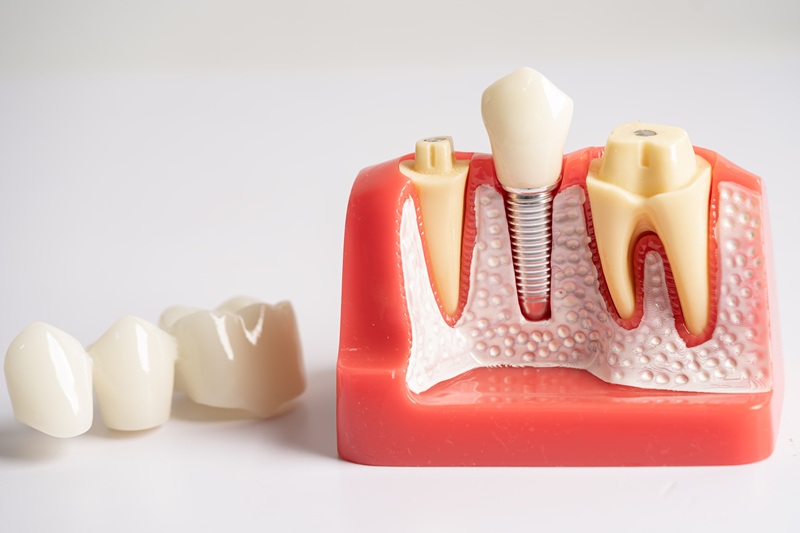What Problems Do Dental Implants Solve?

Chewing, smiling and speaking are some of the few basic things we do that make our days normal. But once a tooth is missing from your teeth, it makes these everyday actions feel uncomfortable and not balanced. On the brighter side, many adults face the same challenge, so you’re not the only one who has this struggle.
One of the most reliable ways to bring back the feel and function of a natural tooth is dental implants. But what exactly do dental implants solve? And are they the right solutions for you?
Let’s take a closer look.
What Are Dental Implants?
Dental implants are a long-term solution used to replace missing one or more teeth. Unlike dentures or bridges that only sit on top of the gums, a dental implant is placed directly into your jawbone, which acts as an artificial tooth root that fuses with your jaw structure.
Once your jaw is healed from the implant, a crown (the visible part of the tooth) is placed on top. The result of the dental implant procedure offers a look, feel and functionality much like a real tooth. Dentists would even say that this is the closest you can get to the teeth you were born with.
Now, what main problems can they solve?
What Problems Do Dental Implants Solve?
1. Replacing Missing Teeth
The most obvious benefit of dental implants is that they fill the gap left behind by a missing tooth. They are designed to replace missing teeth in a way that’s long-lasting and stable. Unlike dentures, that can be prone to slips or feel loose, implants stay firmly in place as they are planted to your jawbone.
2. Restoring Functionality
Chewing becomes more difficult even when just a tooth is missing. You may even avoid certain foods or chew only on one side of your mouth, which will eventually cause uneven wear. A dental implant helps restore proper function, so you can enjoy your meals again without any worry.
They help solve problems like:
- Trouble chewing or biting into food
- Embarrassment from gaps in your smile
- Speech issues caused by missing teeth
- Jawbone shrinkage from long-term tooth loss
3. Preventing Bone Loss
When a tooth is lost, the jawbone in that area no longer gets stimulation, which leads to bone shrinking over time. This process is called bone resorption, where it can alter your face shape and lead to other dental issues along the way.
With the help of a dental implant, bone resorption may be avoided as the post acts like a natural tooth root, stimulating the jawbone and maintaining its strength.
4. Improving Confidence and Appearance
Gaps from missing teeth can make people feel self-conscious. With dental implants, these can help boost your confidence, allowing you to smile, speak and eat without worry.
When Are Dental Implants Not Ideal?
Dental implants are an excellent solution for many people who have a missing tooth or several of them, but not everyone is suitable to get a dental implant procedure. At Whitehorse Dental, we usually have high standards when it comes to our dental implants treatment, and they should be met first. Moreover, dental implants may not always be the first choice for anyone who wants a replacement for their missing tooth.
If a damaged tooth can still be saved with a reliable treatment,like a root canal or a crown, it is often better to preserve the natural tooth. This is because, while implants are very successful, they can still face issues similar to natural teeth, like infection, gum disease or peri-implantitis, especially if not properly cared for.
Also, patients with poor bone quality or certain medical conditions might need additional preparation or alternative treatments.
Dental Implant Surgery: A Quick Step-by-Step Overview
In case you already have the green light for dental implants procedure, it typically starts with an initial consultation where your dentist assesses your eligibility through X-rays, impressions, and a review of your health history.
Here’s a quick step-by-step overview of our dental implant surgery:
1. Tooth Removal & Preparation
If a damaged tooth is present, it has to be removed first to ensure a healthy environment for the implant. In some cases, a bone graft may be needed to strengthen the implant site. Healing time varies after a bone graft procedure, which typically takes a few months before moving to the next step.
2. Dental Implant Placement
Once the area is ready, the titanium implant is placed into the jawbone under local anaesthesia. This is followed by osseointegration, which is the healing period where the implant fuses with the bone to create a solid foundation. This also takes a few months before finally getting a crown over the implant.
3. Crown Placement
A custom-made crown is attached to the implant once healing is done. This final stage will restore both function and appearance of the teeth, offering a long-lasting tooth replacement solution.
Remember that regular dental visits and good oral hygiene are still crucial to keep your dental implants healthy and secure for the long term.
READ MORE: THE ULTIMATE GUIDE TO DENTAL IMPLANTS PROCESS AND TIMELINES
Dental Problems Solved with Long-Term Solutions
Dental implants may be an effective option for people with missing teeth. However, like all dental procedures, suitability varies from person to person.
If you’re wondering whether dental implants are appropriate for your individual situation, a consultation with a qualified dental professional can provide personalised advice. At Whitehorse Dental, we are here to give you access to informational guides on the best treatments that may be appropriate to you.
Book a consultation with us to learn more about our dental implants procedure.

